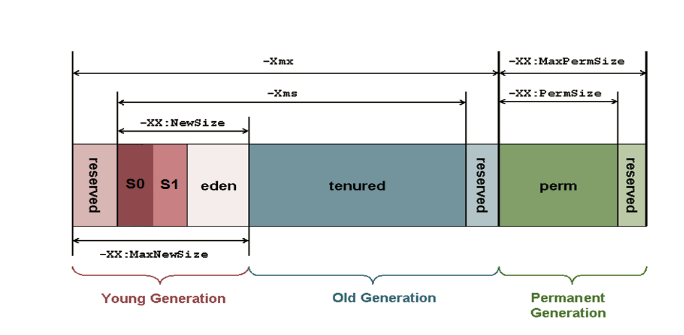
jps (JVM Process Status Tool)
Used to check progress id/ start path/ start argument.
If remote machine running jstat, jps can query remote vm progress.
define:jps [-q] [-mlvV] [<hostid>]
- -m arguments that input into main
- -v arguments that input into jvm
- -l main class package path or jar file path
jmap( Memory Map for Java)
mapping jvm’s object/ reference
define:jmap [option] <pid>
| a | b |
|---|---|
| -heap | heat info |
| -histo[:live] | default in live |
| -dump | live dump only live objects format=b binary format file=path dump heap to |
| -permstat | permanent generation |
| -finalizerinfo | object waiting finaliz |
| -F | force all object dump or histo |
1 | jmap -histo 20836 |
jhat(JVM Heap Analysis Tool)
offline dump file analysis, check memory info.
But Visual interface is much more better like jvisualvm jconsole
jinfo(Configuration Info for Java)
print or modify java progress’s options(flag). print system properties1
2jinfo -sysprops 20836
jinfo -flags 20836
jstat(JVM statistics Monitoring Tool)
monitor jvm grogress’s resource and performence
define:jstat -<option> [-t] [-h<lines>] <vmid> [<interval> [<count>]]
| a | b |
|---|---|
| -class | class’ mateinfo in jvm |
| -compiler | compiler info in jvm |
| -gc | current jvm global info |
| -gccapacity | similar as above |
| -gccause | reason cause gc option |
| -gcnew | youny generation (eden + servivor) |
| -gcnewcapacity | |
| -gcold | old generation |
| -gcoldcapacity | old capacity |
| -gcpermcapacity | perm capacity 1.6 in method space 1.8 in true memory |
| -gcutil | static class ? |
| -printcompilation | compile summary |
| a | b |
|---|---|
| S0 | 年轻代中第一个survivor(幸存区)已使用的占当前容量百分比 |
| S1 | 年轻代中第二个survivor(幸存区)已使用的占当前容量百分比 |
| S0C | 年轻代中第一个survivor(幸存区)的容量 (字节) |
| S1C | 年轻代中第二个survivor(幸存区)的容量 (字节) |
| S0U | 年轻代中第一个survivor(幸存区)目前已使用空间 (字节) |
| S1U | 年轻代中第二个survivor(幸存区)目前已使用空间 (字节) |
| S0CMX | 年轻代中第一个survivor(幸存区)的最大容量 (字节) |
| S1CMX | 年轻代中第二个survivor(幸存区)的最大容量 (字节) |
| a | b |
|---|---|
| E | 年轻代中Eden(伊甸园)已使用的占当前容量百分比 |
| EC | 年轻代中Eden(伊甸园)的容量 (字节) |
| EU | 年轻代中Eden(伊甸园)目前已使用空间 (字节) |
| NGCMN | 年轻代(young)中初始化(最小)的大小 (字节) |
| NGCMX | 年轻代(young)的最大容量 (字节) |
| NGC | 年轻代(young)中当前的容量 (字节) |
| a | b |
|---|---|
| O | old代已使用的占当前容量百分比 |
| OC | Old代的容量 (字节) |
| OU | Old代目前已使用空间 (字节) |
| OGCMN | old代中初始化(最小)的大小 (字节) |
| OGCMX | old代的最大容量 (字节) |
| OGC | old代当前新生成的容量 (字节) |
| a | b |
|---|---|
| P | perm代已使用的占当前容量百分比 |
| PC | Perm(持久代)的容量 (字节) |
| PU | Perm(持久代)目前已使用空间 (字节) |
| PGCMN | perm代中初始化(最小)的大小 (字节) |
| PGCMX | perm代的最大容量 (字节) |
| PGC | perm代当前新生成的容量 (字节) |
| a | b |
|---|---|
| YGC | 从应用程序启动到采样时年轻代中gc次数 |
| YGCT | 从应用程序启动到采样时年轻代中gc所用时间(s) |
| FGC | 从应用程序启动到采样时old代(全gc)gc次数 |
| FGCT | 从应用程序启动到采样时old代(全gc)gc所用时间(s) |
| GCT | 从应用程序启动到采样时gc用的总时间(s) |
| DSS | 当前需要survivor(幸存区)的容量 (字节)(Eden区已满) |
| TT | 持有次数限制 |
| MTT | 最大持有次数限制 |
Troubleshooting
Local Applications Cannot Be Monitored (Error Dialog On Startup)
Description: An error dialog saying that local applications cannot be monitored
is shown immediately after VisualVM startup. Locally running Java applications
are displayed as
Resolution: This can happen on Windows systems if the username contains capitalized letters.
In this case, username is UserName but the jvmstat directory created by JDK is %TMP%\hsperfdata_username.
To workaround the problem, exit all Java applications, delete the %TMP%\hsperfdata_username directory
and create new %TMP%\hsperfdata_UserName directory.
In windows platform if jconsole.exe interface, the local vm disenable, check user name, and directory name:1
2
3
4# If user name is Administrator
C:\Users\Administrator\AppData\Local\Temp\hsperfdata_administrator
# change to
C:\Users\Administrator\AppData\Local\Temp\hsperfdata_Administrator
https://visualvm.github.io/troubleshooting.html#jpswin2
jstack(Stack Trace for Java)
print specific progress’s or remote jvm’s stack info
Links
http://blog.sina.com.cn/s/blog_b0e3dfe30102wfl5.html
http://www.bubuko.com/infodetail-792105.html
https://www.cnblogs.com/lishijia/p/5897236.html
http://www.talkwithtrend.com/Article/161055
https://www.ibm.com/developerworks/cn/java/j-lo-JVMGarbageCollection/
https://www.ibm.com/developerworks/cn/java/l-JavaMemoryLeak/